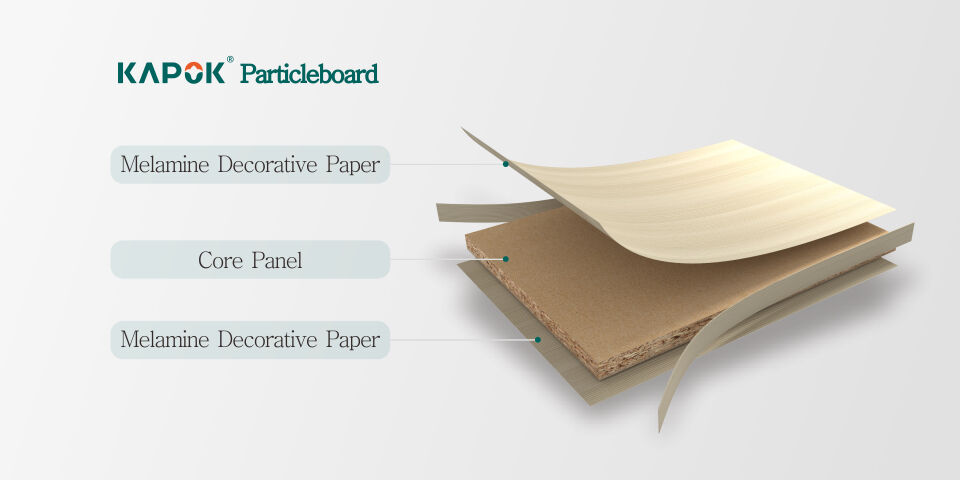KAPOK FQA
How is a fine-quality melamine board created?
Q1 What is a composite board composed of?
Simply put, a composite board consists of two main parts: the base material and the impregnated adhesive film paper. Edge bands and accessories such as hardware are what transform the composite board into the furniture we commonly see.
To draw a metaphor, if a board is likened to a cake, then the base material is the cake base, the adhesive film paper is the outer layer of cream, and edge bands along with hardware are like fruits and cake decorations.

Q2 What is impregnated adhesive film paper?
Impregnated adhesive film paper, also known as melamine impregnated film paper, is a type of plain or printed decorative paper that undergoes impregnation with melamine formaldehyde resin and urea-formaldehyde resin. After drying to a certain extent, it becomes a resin-infused paper with a specific resin and volatile content.
This paper can be thermally pressed to bond with each other or adhere to the base material of engineered wood boards.
It's important to note that the melamine in impregnated paper primarily serves as an adhesive in the production of decorative boards and is not harmful to the human body, considering that the boards are not ingested and do not have an effect.
Q3 What is the steel plate effect?
As the name suggests, it is an effect that resembles a steel plate.
The significance of the steel plate effect lies in giving life to patterns. Once the impregnated paper undergoes thermal pressing with a steel plate, the patterns on the paper come to life, creating visible textures and tangible sensations in the visual appearance.
Q4 What is the base material, and how many types are there?
The base material, also known as the substrate, refers to the carrier on which the impregnated paper is laminated.
The common types of base materials in the market are mainly Medium Density Fiberboard (MDF), Particleboard (chipboard), and Plywood.
Red cottonwood has a total of 7 types of base materials, which are: Medium Density Fiberboard (MDF), Particleboard (chipboard), Wood Fragrance Board, Plywood, Solid Core Board, Original State Board, and Flame Retardant Board.
In other words, whether commonly used or less common, we have them all!
Q5 Could you explain the production process of boards?
In general, the production process of boards can be divided into the following 6 major steps:
1. Dust removal
2. Laying
3. Hot pressing
4. Trimming
5. Cooling
6. Stacking
Q6 Is the choice of base material important?
Yes, it can have a significant impact. Different base materials have different applications. When choosing a base material, besides considering the price, it's essential to look at factors such as environmental grade and physical performance.
For example, those seeking cost-effectiveness may opt for regular particleboard, while solid wood plywood can be chosen for cabinet construction, and oriented strand board can be used for cabinet doors requiring deformation resistance.
Q7 Are the textures I see and feel the same thing?
No, they are not the same.
The textures we see are patterns on the impregnated paper, while the steel plate effect showcases the texture's convexity and concavity. In other words, the ups and downs of our patterns are presented through the steel plate effect, rivaling real wood.
To enhance the consumer's actual experience, Red Cottonwood SuperSense decorative panels have fixed combinations of board patterns and steel plate effects, eliminating concerns about inconsistent textures and tactile sensations.
Q8 Where can engineered boards be applied?
Engineered boards can be used in both home and commercial applications.
Common applications include wall panels/feature walls, wardrobes, cabinets, TV cabinets, entrance cabinets, and more.

 EN
EN









































 ONLINE
ONLINE